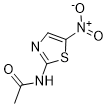Physicochemical Properties
| Molecular Formula | C5H5N3O3S |
| Molecular Weight | 187.17 |
| Exact Mass | 187.005 |
| Elemental Analysis | C, 32.09; H, 2.69; N, 22.45; O, 25.64; S, 17.13 |
| CAS # | 140-40-9 |
| PubChem CID | 8798 |
| Appearance | Solid powder |
| Density | 1.598g/cm3 |
| Boiling Point | 303.8ºC at 760mmHg |
| Melting Point | 263°C (dec.) |
| Flash Point | 137.5ºC |
| Vapour Pressure | 0.000911mmHg at 25°C |
| Index of Refraction | 1.666 |
| LogP | 1.605 |
| Hydrogen Bond Donor Count | 1 |
| Hydrogen Bond Acceptor Count | 5 |
| Rotatable Bond Count | 1 |
| Heavy Atom Count | 12 |
| Complexity | 205 |
| Defined Atom Stereocenter Count | 0 |
| SMILES | S1C(=C([H])N=C1N([H])C(C([H])([H])[H])=O)[N+](=O)[O-] |
| InChi Key | UJRRDDHEMZLWFI-UHFFFAOYSA-N |
| InChi Code | InChI=1S/C5H5N3O3S/c1-3(9)7-5-6-2-4(12-5)8(10)11/h2H,1H3,(H,6,7,9) |
| Chemical Name | 2-Acetamido-5-nitrothiazole |
| Synonyms | Nithiamide; NSC 45914; NSC-45914; NSC45914 |
| HS Tariff Code | 2934.99.03.00 |
| Storage |
Powder-20°C 3 years 4°C 2 years In solvent -80°C 6 months -20°C 1 month |
| Shipping Condition | Room temperature (This product is stable at ambient temperature for a few days during ordinary shipping and time spent in Customs) |
Biological Activity
| References | Efficacy of nithiamide in preventing and treating swine dysentery in experimentally inoculated pigs. Am J Vet Res. 1977 May;38(5):627-31. |
| Additional Infomation |
Aminitrozole is an aromatic amide and a member of acetamides. Nithiamide is an orally available antiprotozoan agent used in the treatment of vaginal trichomoniasis. |
Solubility Data
| Solubility (In Vitro) | DMSO : ~100 mg/mL (~534.25 mM) |
| Solubility (In Vivo) |
Solubility in Formulation 1: ≥ 2.5 mg/mL (13.36 mM) (saturation unknown) in 10% DMSO + 40% PEG300 + 5% Tween80 + 45% Saline (add these co-solvents sequentially from left to right, and one by one), clear solution. For example, if 1 mL of working solution is to be prepared, you can add 100 μL of 25.0 mg/mL clear DMSO stock solution to 400 μL PEG300 and mix evenly; then add 50 μL Tween-80 to the above solution and mix evenly; then add 450 μL normal saline to adjust the volume to 1 mL. Preparation of saline: Dissolve 0.9 g of sodium chloride in 100 mL ddH₂ O to obtain a clear solution. Solubility in Formulation 2: ≥ 2.5 mg/mL (13.36 mM) (saturation unknown) in 10% DMSO + 90% (20% SBE-β-CD in Saline) (add these co-solvents sequentially from left to right, and one by one), clear solution. For example, if 1 mL of working solution is to be prepared, you can add 100 μL of 25.0 mg/mL clear DMSO stock solution to 900 μL of 20% SBE-β-CD physiological saline solution and mix evenly. Preparation of 20% SBE-β-CD in Saline (4°C,1 week): Dissolve 2 g SBE-β-CD in 10 mL saline to obtain a clear solution. (Please use freshly prepared in vivo formulations for optimal results.) |
| Preparing Stock Solutions | 1 mg | 5 mg | 10 mg | |
| 1 mM | 5.3427 mL | 26.7137 mL | 53.4274 mL | |
| 5 mM | 1.0685 mL | 5.3427 mL | 10.6855 mL | |
| 10 mM | 0.5343 mL | 2.6714 mL | 5.3427 mL |
